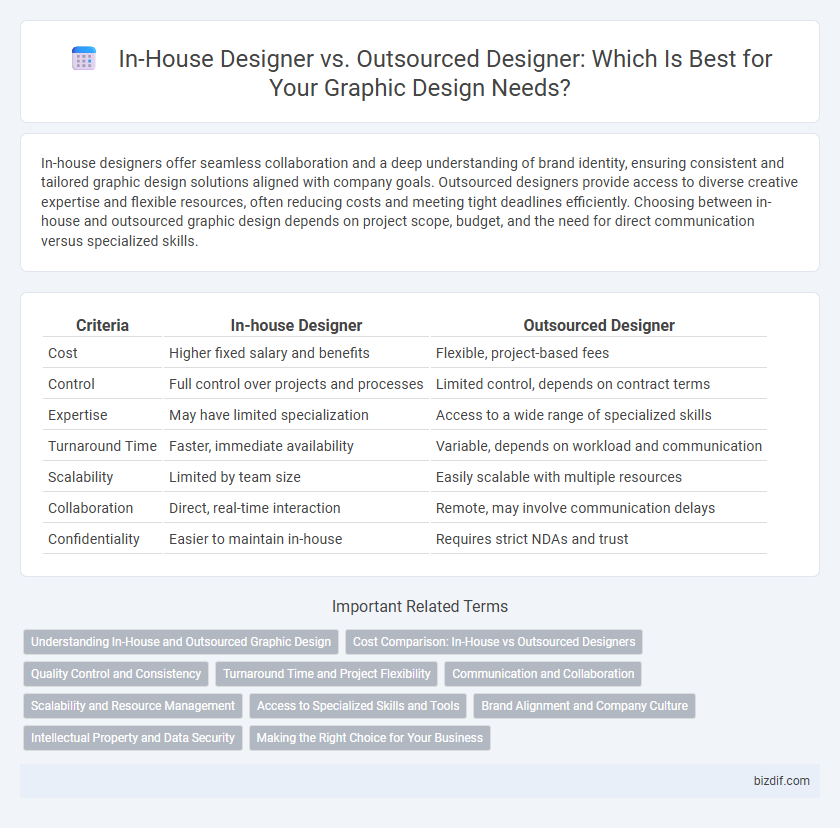In-house designers offer seamless collaboration and a deep understanding of brand identity, ensuring consistent and tailored graphic design solutions aligned with company goals. Outsourced designers provide access to diverse creative expertise and flexible resources, often reducing costs and meeting tight deadlines efficiently. Choosing between in-house and outsourced graphic design depends on project scope, budget, and the need for direct communication versus specialized skills.
Table of Comparison
| Criteria | In-house Designer | Outsourced Designer |
|---|---|---|
| Cost | Higher fixed salary and benefits | Flexible, project-based fees |
| Control | Full control over projects and processes | Limited control, depends on contract terms |
| Expertise | May have limited specialization | Access to a wide range of specialized skills |
| Turnaround Time | Faster, immediate availability | Variable, depends on workload and communication |
| Scalability | Limited by team size | Easily scalable with multiple resources |
| Collaboration | Direct, real-time interaction | Remote, may involve communication delays |
| Confidentiality | Easier to maintain in-house | Requires strict NDAs and trust |
Understanding In-House and Outsourced Graphic Design
In-house graphic designers offer direct collaboration and align closely with company culture, enhancing brand consistency and faster project turnaround. Outsourced designers bring diverse industry experience and specialized skills, often providing cost-effective solutions for varied design needs. Understanding these dynamics helps businesses choose the best approach for creative control, budget, and project scope.
Cost Comparison: In-House vs Outsourced Designers
In-house designers typically incur fixed costs such as salaries, benefits, and workspace, leading to higher upfront expenses but greater control and integration within the company. Outsourced designers offer flexible payment options, often charged per project or hour, which can reduce overhead and provide access to specialized skills without long-term commitments. Evaluating cost-effectiveness depends on project volume, quality requirements, and the need for ongoing collaboration versus one-time tasks.
Quality Control and Consistency
In-house designers offer superior quality control and consistency by working closely with the internal team and aligning their work with the brand's evolving standards. Outsourced designers may deliver high-quality results but often face challenges maintaining consistent brand identity due to less frequent communication and limited integration with company culture. Ensuring clear guidelines and regular feedback loops is essential when outsourcing to achieve design consistency comparable to in-house teams.
Turnaround Time and Project Flexibility
In-house designers typically offer faster turnaround times due to immediate access and continuous availability, allowing for rapid revisions and real-time collaboration. Outsourced designers may have longer delivery schedules influenced by project scope and external workload but often provide greater flexibility by leveraging diverse expertise across various industries. Balancing in-house immediacy with outsourced adaptability is crucial for optimizing project timelines and creative outcomes in graphic design.
Communication and Collaboration
In-house designers benefit from immediate access to team members, fostering seamless communication and real-time collaboration that aligns closely with company culture and project goals. Outsourced designers rely heavily on digital tools and scheduled meetings, which can sometimes slow feedback loops and create challenges in maintaining consistent brand messaging. Companies must weigh the trade-offs between in-house responsiveness and outsourced flexibility to optimize design workflows.
Scalability and Resource Management
In-house designers offer consistent availability and deep integration with company culture, enhancing communication and immediate feedback loops, which streamlines resource management for ongoing projects. Outsourced designers provide scalable solutions by allowing companies to access diverse skill sets on demand without long-term commitments, effectively managing costs during peak workloads or specialized tasks. Balancing in-house talent with outsourced expertise optimizes scalability and resource allocation to meet fluctuating design demands efficiently.
Access to Specialized Skills and Tools
In-house designers offer consistent access to company-specific knowledge and proprietary tools, ensuring alignment with brand identity and quick iteration cycles. Outsourced designers provide a broader range of specialized skills and access to diverse software and cutting-edge technologies, often bringing fresh perspectives and expertise unavailable internally. Choosing between in-house and outsourced design depends on the need for immediate collaboration versus specialized capabilities and advanced resources.
Brand Alignment and Company Culture
In-house designers offer deeper brand alignment by immersing themselves daily in the company culture, ensuring consistent and authentic visual messaging that resonates with organizational values. Outsourced designers, while skilled, may require extensive briefing to capture the brand's unique voice and often lack the nuanced understanding of company culture needed for cohesive design outputs. Maintaining brand consistency and cultural relevance is more seamless with in-house teams due to their ongoing collaboration and direct access to internal feedback loops.
Intellectual Property and Data Security
In-house designers offer greater control over intellectual property rights and data security by keeping sensitive projects within the company's secure environment. Outsourced designers may pose risks related to data breaches or unauthorized use of proprietary materials due to less direct oversight. Establishing clear contracts and non-disclosure agreements is essential to protect intellectual property when collaborating with external graphic design professionals.
Making the Right Choice for Your Business
Choosing between an in-house designer and an outsourced designer depends on factors like budget, project scope, and control over the creative process. In-house designers provide consistent branding and immediate collaboration, ideal for businesses needing frequent design updates. Outsourced designers offer specialized skills and cost-effectiveness for short-term projects or firms lacking internal resources, ensuring flexibility and diverse creative input.
In-house Designer vs Outsourced Designer Infographic

 bizdif.com
bizdif.com